Written by John Edward Betancourt 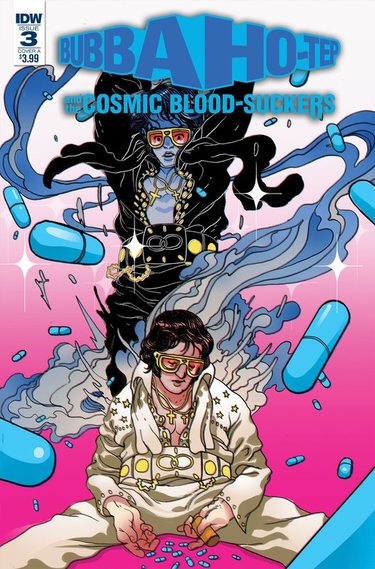 It’s rare that I take the time to re-read a comic series simply because there’s so much more on my list to dig into and for me, once I’ve gone through an issue, I feel as though I’ve absorbed what I need to absorb. But Bubba Ho-Tep and the Cosmic Blood-Suckers is a series that I continually find myself returning to simply because its magnificent story and design is incredibly unique. In fact, I’m hard pressed to think of any other comic series that is able to switch tone and design from issue to issue and still provide the reader with such a rich and amazing experience. Take the first issue for example, which more or less introduced us back into the world of Bubba Ho-Tep by providing us with a story that looked and felt like the iconic motion picture, complete with a beautiful narration that channeled the spirit of Bruce Campbell as Elvis Presley and it was nicely counterbalanced by the fascinating second issue, wherein the audience was treated to a master class on comic book writing, since this particular tale was able to provide the reader with quality and important exposition that moved at a brisk and engaging pace and well, now that I had some free time to settle in and pick up the third issue of this comic, I was quite curious as to what wonders awaited me within its pages. As it turns out, Issue #3 was going to be more of the wonderful same from this series, in that, this time around, the movie-esque feel and outright exposition present in the first two issues was replaced by something that I think we’ve all been waiting for, and something that Issue #2 implied was on its way, sweet and glorious conflict between the King’s cadre of spirit fighters and the evil now present in our world and man, this issue didn’t waste any time getting to down to business in the slightest because this one, features an epic battle so incredible, that the reader needs to take their time going through every single page of this battle royale in order to savor its wonder properly. Because the stunning artwork present here, allows for the eyes to simply feast upon the buffet of violence present in this story and I was utterly captivated by every single frame as the King and his cohorts took care of business in brilliantly gory and gooey fashion and well, it’s rare to read a comic book that actually manages to make the action on the page be as compelling as it is on the silver screen, but that’s precisely what happened here and I loved every single page of this dynamic and bold issue. I call it bold, simply because one would think it’s a touch taboo to put together an issue full of glorious violence, but hey, Writer Josh Jabcuga and Artist Tadd Galusha pulled it off without a hitch. But, there is more to be found in this issue than mystical swords and giant spirits kicking ass and taking names in the bayou. There is quite the important plot point introduced in this one in that, one of the group’s own, Jack, was kidnapped by the evil, to be used as bait to see if the monsters can draw the King and his friends into a fight on their territory and well, that sets the stage for another incredible issue. Because there’s a fair chance that the group will fail and suffer incredible losses if they go after Jack. But something tells me the King won’t leave a man behind and sadly, I’ll just have to wait until the next issue of this magnificent comic to see how this little twist wraps up. Until next time.
0 Comments
Written by Joel T. Lewis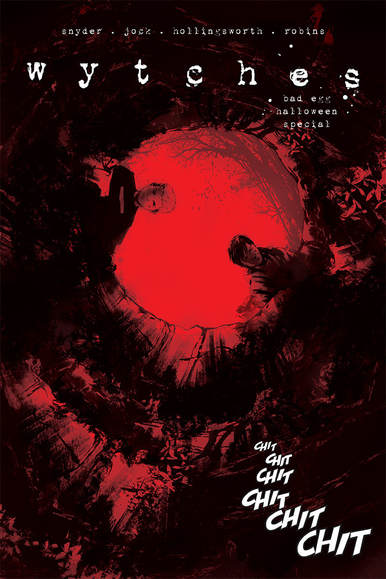 One of the signs of a great comic book collaboration is the creative team’s ability to redefine a known quantity, to come at familiar material from a new angle. Thanks to generosity of the artist Jock, I was able to read an advance copy of just that sort of collaboration: Scott Snyder and Jock’s Wytches: Bad Egg. The original Wytches series which began with Snyder and Jock’s not-so-subtle rejection of the traditional mythology of witches (the first two pages show the definition of witch as it appears in the dictionary on the first and then the same definition shredded by some unseen horror on the second) banked on their ability to reframe our understanding of a very commonplace figure of horror. The sales and wild popularity of that first 6-issue arc make a pretty good case for their having succeeded. The newly-minted creatures that Snyder termed ‘Wytches’ are far more sinister, mysterious, and interesting than the broom-striding hags whose more demonic origins (widely defined and subsequently criminalized by the publication of 1487’s Malleus Maleficarum, Latin for the ‘Hammer of Witches’) have in recent years faded into the background as witches have become more quaint figures of horror. Bad Egg is an excellent continuation by way of prequel of the mythos of these twisted horrifying creatures. It also doubles down on the domestic tension between children of a certain age and parents whose cruelty is incalculable. I like to think that effective Horror is what happens when domestic tensions are monstrously manifested in the world. The notion that the smallest of humanity’s quibbles, those small-minded moments of rage, discontent, and frustration that are uniquely human, might be taken to a very dark place and become something truly horrifying. This is executed with startling familiarity in the interactions between parents and children in Bad Egg as adolescent insecurities about how one measures up to parental expectations are stretched to twisted and monstrous proportions. Mirroring the first arc’s treatment of the classic witch myth, Jock manages to subvert the expectations of the first arc's twisted horrors cloaked in darkness by showing us those same creatures bathed in sunlight, and the effect is no less terrifying. Jock is a master of obscurity and horror through a kind of suburban strangeness and the pages that made the first arc of the series iconic, depicting chitt-chitttering blue and black heaps of tooth and claw and hunger echo and inform the art of this next chapter in new and vibrant ways. Jock’s figures’ features are starker and sharper than reality and the speckled appearance of colorful textures layered over the scenes of seemingly domestic calm build tension through the audience’s curiosity and awe. Though my reading of this installment was definitely enhanced by the recent memory of Sailor Rooks’ discovery of what the Wytches were and what they were after in the first trade, Bad Egg is a great jumping on point for the world of Wytches, as it transitions from the domestic to the supernatural smoothly and swiftly within the first few pages. It recaptures the mystique and looming fear built up by the first 6 issues and tells a uniquely tense tale in the span of 80 pages. Bad Egg is a superb continuation of the unique brand of horror created when Scott Snyder and Jock collaborate and one that you will not be disappointed in picking up when it is released on Wednesday October 31st. Until Next Time, Geek On! Special Thanks goes out to the Artist Jock who graciously provided Nerds That Geek with a Review Copy of Wytches: Bad Egg! Written by Zeke Perez Jr. 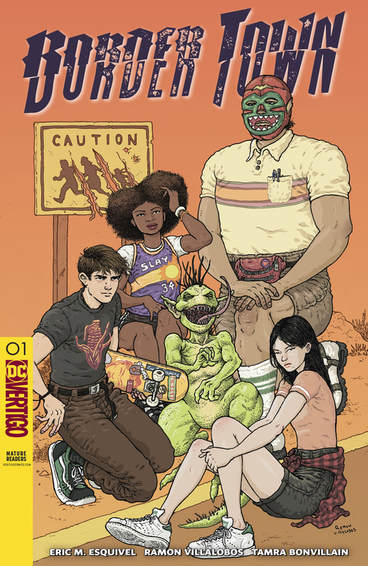 Every now and again, a comic series turns up that holds a mirror to society in a smooth, thought-provoking, and entertaining manner. Border Town makes itself a must-read by being that series of 2018. At a time in U.S. history when political and racial tensions are flaring up, Border Town inserts itself into the conversation with jarring and witty commentary. The comic isn’t all business, though. It provides well-crafted humor amidst supernatural action from a crew of awesome characters and mythological creatures. If there’s a better recipe for entertainment, I’m not sure where to find it. The new series, published by Vertigo, focuses in on Devil’s Fork, Arizona; a city near the U.S./Mexico border where creatures from Mexican folklore have sprung up, thanks to a crack in the border between physical dimensions. The creatures that first appear (wild chupacabras) take the form of the greatest fear of the person seeing them. For racist xenophobes, they appear as the stereotypical Mexican immigrants (except larger and more lizard-like). For those immigrants, the chupacabras shift into ICE agents. The wild new creatures stir up trouble in town, crossing paths with new-kid-in-town Frank Dominguez and a crew of other high school misfits. Through the lens of Devil’s Fork residents, Border Town pokes fun at and takes a deep look into American race relations. While the story’s characters are pretty on the nose, they are still very intriguing - especially as you learn more about each one and as they begin to interact with each other. Border Town gave me one of the most profound and personal experiences I’ve ever had when reading a comic - or any book, for that matter. In the first issue, Frank introduces himself to Julietta by saying that he’s half-Mexican and half-Irish. She responds by telling him he’s wrong; he’s not ‘the world’s shittiest centaur’, composed of ‘half’ and ‘half’. He’s actually Mexican and Irish AND American, all three fully, and all three simultaneously. Three hundred percent.’ As someone who’s struggled with his identity growing up, this truly touched me. I’ve always referred to myself as half-Mexican, half-Italian, and American, or some combo of those three things. I’ve found myself shifting between those identities, acting as a chameleon based on the surroundings or situation. But I’ve never thought to put the emphasis on myself being the entirety of those things, not just part of each. That writing by Eric M. Esquivel, that phrasing, and that realization meant so much to me. To build off of that, the true treat for me in reading Border Town is the spotlight it shines onto Latino and Mexican-American culture. Specifically, issue #2 blew my mind and filled me with joy. I grew up hearing stories of la chupacabra, El Cucuy, and (most hauntingly for me) La Llorona. I was amazed to flip open artist Ramon Villalobos’ and colorist Tamra Bonvillain’s beautiful double-page spread featuring a lineup of those and other Mexican folk legends. The two-pager is a work of art that would make for an astounding print. The preceding panel depicting Mictlantecuhtli is unbelievably dope too. Seeing these figures drawn up inside a comic book is not something I’d ever thought I’d experience. Representation is pretty great. I’m not sure that I would have predicted that I would ever read a teen supernatural horror story with Latino influences and a strong social message coated in terrific writing and humor, but Border Town cooks that blend up to perfection. It’s not too late to jump in on the action! The second printing of the extremely popular first issue drops today (10/10) and the third issue will release on November 7th. There’s still plenty of time to see how Frank Dominguez and his new crew from Devil’s Fork will band together to stop the folklorical legends that are invading the town on the border… Written by Zeke Perez Jr. 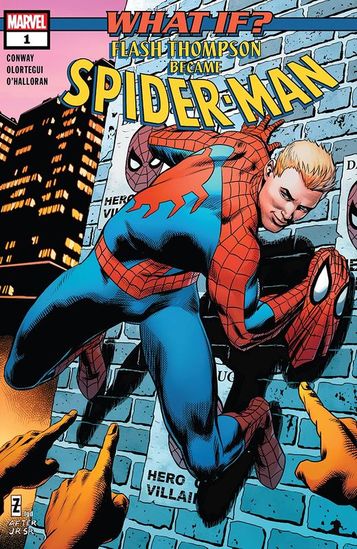 Possibly fueled by my love for Back to the Future, I have always been fascinated by the idea of multiple universes and alternate realities. The idea that a single, simple decision could change everything about the world is captivating. Blossoming from its theoretical and philosophical roots, the mutliverse theory has become somewhat of a staple in popular culture. The ideas of butterfly effects, time travel, and parallel universes have long appeared in movies (the aforementioned BTTF, The Terminator, and It’s a Wonderful Life, to name a few), TV shows (various episodes of Rick & Morty, Futurama, and The Twilight Zone), and comics. Marvel has had quite a bit of fun with the concept over the years in their ‘What If’ series. ‘What Ifs’ are some of my favorite comics to collect, so I was thrilled when Marvel announced in July that they would be bringing them back for another run this fall. The superheroes we know and love have powers, traits, morals, and qualities that stem from their origin stories and other defining moments. They interact with their environments and with other characters in ways that we’ve come to expect. We know that Batman’s drive emanates from the death of his parents, or that Uncle Ben’s lessons on responsibility guide Spider-Man. But what if the canon is changed? Marvel started playing with that idea with the first volume of ‘What If’ comics back in 1977, asking questions like ‘What if Spider-Man had joined the Fantastic Four?’, ‘What if The Hulk had Bruce Banner’s brain?’, or ‘What if Elektra had lived?’ (one of my favorite ‘What If’ comics that I own). These comics take us into other realities, either by changing the core of heroes or putting them into situations we may have never considered. This week, I picked up the two newest editions from Marvel’s 13th volume of ‘What If’ comics: ‘What If? Spider-Man #1’ and ‘What If? X-Men #1’. “What If? Spider-Man #1”: What if Flash Thompson had become Spider-Man? ‘What If? Spider-Man #1’ is a well-crafted tale of duality that, with a simple but important character swap, sends shockwaves through the entire Spidey-verse. It is brains vs. brawn. Responsibility vs. recklessness. Morality vs. conceit. Flash Thompson vs. Peter Parker. The simple premise - Flash Thompson gets bitten by the radioactive spider instead of Parker - leads to a captivating story that amplifies the importance of each character’s personality. With Flash taking the spider bite, Parker never becomes the friendly neighborhood Spider-Man. Though he’s still kind-hearted, he fails to gain the confidence, strength, and wittiness that Spider-Man has, instead remaining timid and unassuming. Flash, on the other hand, remains unchanged after the bite. He’s the stereotypical jock: cocky, powerful, and ego-driven. But his unchanged character means big changes for Spider-Man. Flash’s Spidey is a little more violent with criminals, a little less friendly to New Yorkers, and a lot less responsible. Without the Uncle Ben background that Parker’s Spidey has, Flash’s Spidey has little guiding him to do the right thing. Even J. Jonah Jameson is different in a Flash universe, idolizing Spider-Man as a figure he thinks could have saved his son John, rather than despising the Parker Spider-Man for (ironically) actually saving his son and feeding into his sensationalist views.  The comic brings together excellent writing from the legendary Gerry Conway and solid art from Diego Olortegui. Conway contributed to some of the biggest storylines in Spider-Man history, something that really showed as he spun this new tale. The story makes great use of its narrator, told through the eyes of a Watcher-like character (with an interesting twist… spoiler reserved). This isn’t the first time Marvel has taken a crack at a ‘Flash as Spider-Man’ story. In fact, the very first run of ‘What If’ comics featured one in its seventh issue, looking at how Flash, Betty Brant, or John Jameson would have fared as Spidey. The second volume of ‘What If’ comics featured another Flash story too. So, while this take wasn’t the first, it potentially rises above the others and, at the very least, it got me excited for the rest of the new ‘What If’ run! “What If? X-Men #1”: .exe-Men ‘What If? X-Men #1’ is a ‘What If’ tale for the modern age. With the feel of a Black Mirror episode, it focuses on a futuristic technology-driven society with a unique and interesting spin for the X-Men mutants. The story takes place in a 21st century society where bio-modified humans can interact in a virtual world dubbed ‘cyberspace’. The world is heavily secured and commodified, with crippling restrictions. However, a group of people find that they have the ‘.exe gene’, a mutation that allows them to manipulate this cyber world. Those with the mutation are, of course, this universe’s X-Men. Just like the traditional X-Men, they are persecuted by the government and feared by society for their differences. They are forced to register and prevented from entering cyberspace for fear of the weapons they can create within the virtual world and the havoc they can cause as a result. The story focuses on Cable and Domino who, at the request of Professor Xavier, seek to fight a government-created virus that would exterminate .exe mutants. It truly is a take on the X-Men universe that could only have been written in the tech age. The art, completed by the duo of Neil Edwards and Giannis Milonogiannis, does a lot for this comic. There are a few stunning splash pages, scattered in between beautiful pages that depict both the real world and the virtual world. The pages where Domino’s voyage into the virtual world were marked with Tron-like designs and calm pinks, greens, and blues were my favorites, visually. Bryan Edward Hill’s writing makes the conflict feel suspenseful and tense; you can tell the stakes are high. It was a complex story that left me with a few unanswered questions to make sense of, but it’s highly entertaining and fits nicely in the X-Men mythos. Written by Joel T. Lewis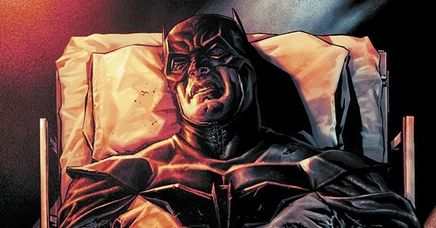 DC Comic’s Black Label imprint is a puzzling experiment. For a company whose traditional avenue of releasing more mature themed content has been its Vertigo Imprint, and whose numerous collaborations with IDW and Dynamite Comics for Batman, Shadow, Ninja Turtles, and even the upcoming mini-series with the Maxx in October indicate the flexibility of the company in terms of non-traditional or mature content, to create another subset of publication doesn’t seem to make a whole lot of sense. But with a Batman title, the creative team behind the (2008) graphic novel entitled Joker, and a storyline about a murdered clown prince of crime and an amnesiatic Batman I wasn’t one to balk at buying in to the latest DC gimmick. The strength of that team, and the story concept was what swayed me as I stood in my local comic shop, agonizing over the oversized (with a price to match) issue. I brushed away my misgivings over the summaries I read and the prominence of John Constantine they spoke of. Nothing against the Hellblazer, but I’ve never been a big fan of the chain smoking cockney occult expert so the idea of him featuring heavily in this mini-series was enough to give me pause. The long and short of it is that this title is hobbled by a number of factors and despite the strength and skill of creators Azzarello and Bermejo the issue falls short. The premise of Brian Azzarello and Lee Bermejo’s Batman: Damned series can be summed up by two central elements: 1) the Joker is dead and 2) Batman can’t be sure he didn’t kill him. Throughout this issue we follow the Dark Knight as he wades amid hazy short-term memories and vivid flashbacks trying to piece together what happened the night the Homicidal Harlequin was murdered. Narrated by John Constantine, this issue has a heavy Justice League Dark leaning as Batman interacts with the Hellblazer, Boston Brand (Deadman), and Enchantress who continues to pop up in Bruce’s sinister remembrances of the period before his parents died. Azzarello hints pointedly at the Wayne’s shaky marriage in Bruce’s flashbacks, showing Thomas to be kind of an unfaithful sleaze and highlights Bruce’s desperation as he tracks down leads as to who might have killed the Joker. Bruce must find any scrap of evidence that leads away from him as the prime suspect because to entertain that he’d finally gone too far, would break the Bat’s spirit and undermine his whole crusade. Now just from a purely subjective standpoint, I don’t like the notion of a morally corrupt Thomas Wayne, though that does not discount the important narrative point Azzarello makes with these unfaithful overtures. Bruce Wayne never grew up to discover the fallibility of his parents. Ripped from him as they were so violently in that dark alley years ago, Bruce only ever saw them as the bright shining beacons of hope and generosity for the city of Gotham. They were martyrs, unfortunate victims of a city they only ever wanted to improve and benefit. This is in part why Batman exists; seeing the cruelty of Gotham in response to the public generosity and benevolence of the Waynes, Bruce opts for a darker approach as a way of creating a Gotham in which the brutal murder of his parents could never happen again, but also the Gotham that his parents worked so hard to create. In a way, Bruce is filling the void in Gotham created by the murder of his parents with Batman, a way of externalizing the loss he himself experiences and the void he can never fill for himself. But also, Bruce in blaming himself for his parents’ murder plays the role of Batman as a way of making up for having himself deprived the city of his parents, of who he always perceived as Gotham’s saviors. When we learn, as Bruce does through these flashbacks, that Thomas and Martha Wayne were on the rocks and that the extramarital overtures of his father threatened the sanctity of their union it is startling how similar those implications are to what Batman finally murdering the Joker would mean. Discovering that our parents aren’t gods can be earth-shattering. It reshapes how we understand the world and our role within it. Finding out the idyllic impression of his parents, the pillars of Gotham’s upper crust in matters of philanthropy and good will were fallible, cruel even, threatens the foundation of the theory of Batman. In the way Batman murdering Joker would undermine the integrity of the Dark Knight’s Crusade, so too would discovering that the Waynes’ fallibility call into question Batman’s existence and the foundation of his philosophy. Azzarello seems to posit that the vision Bruce had of his parents, the void he feels compelled to fill for Gotham, is a boy’s vision of his parents; illogical, idyllic, and foolish. Which is a great point to make, if an uncomfortable one. Now where this issue really struggles for me, is in narration. The Brit Noir style narration is not an inherently bad choice especially for character like John Constantine who serves as a morally ambiguous occult Detective. But rather than acting as a frame or setting the scene for the action we see following Bruce as he investigates Joker’s murder, the way Constantine‘s narration appears on the page is not so much integrated as it is an interruption. The letters take on a kind of journal-ed handwriting typeset cascading down the larger splash pages of the issue which are not only difficult to read within the color schemes chosen but is not helped by the fact that what you’re trying to read is Constantine‘s colloquial cockney dialect. Dialect and accent are elements of character that when spelled out phonetically as they are in this hinder the pacing of the issue by forcing you to stop to re-read passages. Opting for this phonetic spelling of Constantine’s unique manner of speaking is not in itself problematic but when combined with the typeface chosen the effect is compounded as what was difficult to interpret because of the colloquial nature of the speech is now indecipherable. Now this might be a grievance for me to level at the feet of this issue’s Letterer Jared K. Fletcher, but I think the failure of the narration must be shared by Azzarello in scripting the book. Where Azzarello really shines in this book is in his creation of a spiritual sequel to his own mediation on the Clown Prince of Crime Joker published in 2008 and Alan Moore’s sinister exploration of the character in 1988’s The Killing Joke. In the opening lines of Constantine’s narration, he talks about the thin line between black and white, love and hate, and life and death reminding him of an old joke about insanity and a beam of light. The joke in question deserves its own treatise but to summarize rather than ruminate it hinges on one lunatic’s insane belief in something that is not possible existing in the same breath as his practical faith in humanity’s proclivity for cruelty. Even in a world mad enough for man to walk across lamplight, the charity of man is too much to hope for. The ambiguity of Moore’s ending; the long duet of bat and clown laughter which stops as a beam of light is fractured and disappears on the ground beneath them strongly suggesting that Batman has finally killed the Joker is arguably the most appropriate conclusion to their narrative. Batman’s final realization of Joker’s inability to be redeemed and the equally likely outcomes of murder or mercy maintain the tension that defines the two characters and their inability to solve each other. 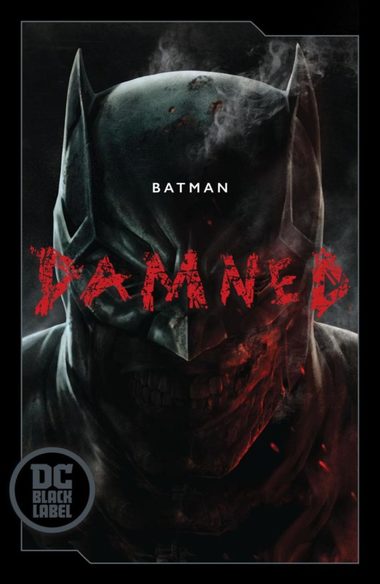 In the climax of his own mediation on the Joker, Azzarello likens him to a disease. Chronicling the infection of generic henchmen extraordinaire Jonny Frost as he descends further and further into a borrowed madness that graphic novel ends with a particularly brutal bridge fight between hero and villain with the newly mad Frost leaping away from the escalating violence. The concluding page of the novel depicting Jonny’s final leap is mirrored on page 9 of Damned with Batman’s injured leap off the bridge and the news coverage reporting the discovery of the Joker’s body in the Gotham River strongly suggests that this story picks up where the previous one left off. Now I’ve gone a far distance in this review without acknowledging the limp shadowy elephant in the room but the time has come at last to discuss the first appearance of Bat-Genitalia in a Comic Book. We see Bruce Wayne’s penis in this issue. There have been complaints, memes, and finally cancelled reprints. Here’s my problem with the penis: it added nothing to this book. It seems to be the only element of this issue, apart from language to warrant the black label mature content imprint. DC created a whole new imprint, a new division of their publishing company in order to show me Batman’s dick. This is no way a prudish objection to the concept of full-frontal male nudity, with the gratuitous oversexualization of female characters in comics from every publisher since their inception I believe it is time at last to bring on the dongs. What I object to is creating a whole new imprint with the expressed purpose of generating mature content and turning out an issue as flaccid as this was. I will again compare this issue to the Joker graphic novel, which was released as a single volume with no mature content warning 10 years ago with no phallic-fueled internet buzz whatsoever. On page 20 of that book Joker pushes a man he’s skinned from the neck down on to the lit stage of a strip club. Joker murders an elderly couple in bed with a straight razor and sleeps on top of their still bleeding corpses. Broken bottle skull-bashing, hangings, at one point Joker shoots through both Jonny’s cheeks thus creating another ghoulishly smiley villain in the process. You might say this comparison is unfair but that’s not the case. This issue demands comparison. The same author with the same artist with panels that directly reference the graphic novel? Azzarello means this to be a continuation of that story at least in spirit, and it’s a poor heir indeed. My point is this: Azzarello is your guy for a mature Joker centered book, no question. He’s shown us before that he can make comics gory, mature, terrifying, and quality. But what this issue seems to indicate is that Azzarello came to DC with a story which they proceed to chop up and shove into a trendy little package, playing on the adult imagery of the ‘Black Label’ title. And who knows? Maybe the following issues will find a way to better justify the mature content warning, but in 48 pages of overly-wordy and distracting exposition the only element to warrant the mature label is a penis cloaked in the Batcave’s lighting? Give me a break. This is yet another of DC’s outdated and feeble cash-grab ploys that shore-up audience anticipation and utterly fail on delivering anything promised. You know what sold me on this book? The reason I ignored my better judgement in picking this title up was remembering the strength of Lee Bermejo’s artwork on Joker. I thought, ‘Well if it sucks, at least the artwork will be killer.’ I was right. The only fault I can lay at Bermejo’s feet in this issue is that his artwork is spoiled with the interruption of the lettering and diminished by its inclusion in so feeble a marketing exercise. This is a frustrating state to be in dear reader, and I hope to level subjective criticism rather than fanboy niggling. This is an ambitious story and an important story with incredible artwork, it’s just a shame it’s so poorly put together. Until Next Time, Geek On. |
Archives
May 2024
|
|
© 2012-2025, Nerds That Geek LLC.
All Rights Reserved. |
uWeb Hosting by FatCow
